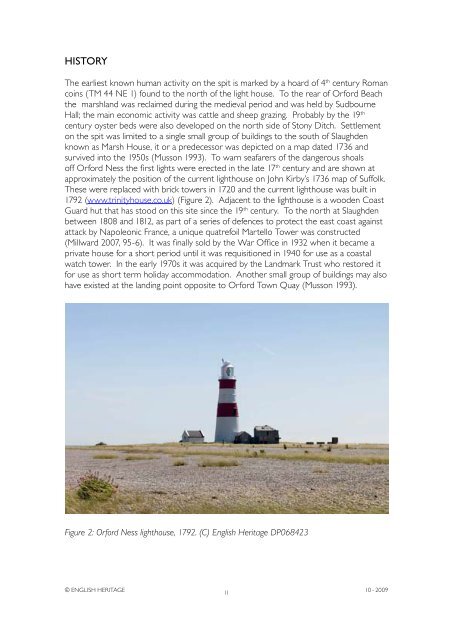Atomic Weapons Research Establishment. Orford ... - English Heritage
Atomic Weapons Research Establishment. Orford ... - English Heritage
Atomic Weapons Research Establishment. Orford ... - English Heritage
You also want an ePaper? Increase the reach of your titles
YUMPU automatically turns print PDFs into web optimized ePapers that Google loves.
History<br />
The earliest known human activity on the spit is marked by a hoard of 4 th century Roman<br />
coins (TM 44 NE 1) found to the north of the light house. To the rear of <strong>Orford</strong> Beach<br />
the marshland was reclaimed during the medieval period and was held by Sudbourne<br />
Hall; the main economic activity was cattle and sheep grazing. Probably by the 19 th<br />
century oyster beds were also developed on the north side of Stony Ditch. Settlement<br />
on the spit was limited to a single small group of buildings to the south of Slaughden<br />
known as Marsh House, it or a predecessor was depicted on a map dated 1736 and<br />
survived into the 1950s (Musson 1993). To warn seafarers of the dangerous shoals<br />
off <strong>Orford</strong> Ness the first lights were erected in the late 17 th century and are shown at<br />
approximately the position of the current lighthouse on John Kirby’s 1736 map of Suffolk.<br />
These were replaced with brick towers in 1720 and the current lighthouse was built in<br />
1792 (www.trinityhouse.co.uk) (Figure 2). Adjacent to the lighthouse is a wooden Coast<br />
Guard hut that has stood on this site since the 19 th century. To the north at Slaughden<br />
between 1808 and 1812, as part of a series of defences to protect the east coast against<br />
attack by Napoleonic France, a unique quatrefoil Martello Tower was constructed<br />
(Millward 2007, 95-6). It was finally sold by the War Office in 1932 when it became a<br />
private house for a short period until it was requisitioned in 1940 for use as a coastal<br />
watch tower. In the early 1970s it was acquired by the Landmark Trust who restored it<br />
for use as short term holiday accommodation. Another small group of buildings may also<br />
have existed at the landing point opposite to <strong>Orford</strong> Town Quay (Musson 1993).<br />
Figure 2: <strong>Orford</strong> Ness lighthouse, 1792. (C) <strong>English</strong> <strong>Heritage</strong> DP068423<br />
© ENGLISH HERITAGE<br />
11<br />
10 - 2009

















